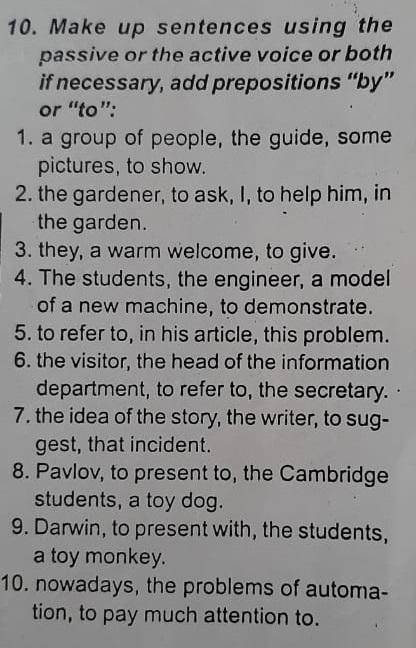Make up sentences using the passive or the active voice or both if necessary, add prepositions "by” or "to”: 1.a group of people, the guide, some pictures, to show.
2.the gardener, to ask, I, to help him, in the garden.
3.they, a warm welcome, to give.
4.The students, the engineer, a model of a new machine, to demonstrate.
5.to refer to, in his article, this problem.
6.the visitor, the head of the information department, to refer to, the secretary.
7.the idea of the story, the writer, to suggest, that incident.
8.Pavlov, to present to, the Cambridge students, a toy dog.
9.Darwin, to present with, the students, a toy monkey.
10.nowadays, the problems of automation, to pay much attention to.

Другие вопросы по теме Английский язык
Популярные вопросы
- Почему Гитлер выбирал слабых союзников в ПМВ и ВМВ?...
1 - Среднее арифметическое двух чисел равна 27.Найдите второе число,если первое...
1 - Реши уравнение: −3y−19=5y+21. ответ: y= ....
3 - Составить технологическую карту одной детали подставки под горячее !)...
1 - С словаря уточните род грамматические формы имён существительных при употреблении...
2 - Чим відрізняється генетичний матеріал еукаріотичних клітин від генетичного...
3 - С какой высоты упал камень массой 400 г,если сила тяжести совершила работу...
1 - Установите соответствие. 1)Покрытосеменные, 2)Голосеменные. плоды с семенами...
2 - ¿Dónde y qué estudió Vasili Kandinski? ¿En qué ciudades y en qué países vivió?¿Cuándo...
3 - Какой ряд правильно и последовательно называет местоимения: ЭТОТ, ДРУГОЙ,...
2
Explanation: In this sentence, the active voice is used. The guide is the subject of the sentence, and "showed" is the verb. The pictures are the object of the verb. The preposition "to" is used to indicate the direction of the action (showing the pictures to the group of people).
2. I asked the gardener to help him in the garden.
Explanation: In this sentence, the active voice is used. I am the subject of the sentence, and "asked" is the verb. The gardener is the object of the verb. The preposition "to" is used to indicate the purpose of the action (asking the gardener to help).
3. They were given a warm welcome.
Explanation: In this sentence, the passive voice is used. "They" is the subject, and "were given" is the passive form of the verb "to give." A warm welcome is the object of the verb. No prepositions are necessary in this sentence.
4. The engineer demonstrated a model of a new machine to the students.
Explanation: In this sentence, the active voice is used. The engineer is the subject, and "demonstrated" is the verb. A model of a new machine is the object of the verb. The preposition "to" is used to indicate the direction of the action (demonstrating the model to the students).
5. He referred to this problem in his article.
Explanation: In this sentence, the active voice is used. He is the subject, and "referred to" is the verb. This problem is the object of the verb. The preposition "in" is used to indicate the location or context of the action (referring to the problem in his article).
6. The visitor referred to the secretary to the head of the information department.
Explanation: In this sentence, the active voice is used. The visitor is the subject, and "referred to" is the verb. The secretary is the object of the verb. The preposition "to" is used to indicate the direction of the action (referring the secretary to the head of the information department).
7. The writer suggested that incident as the idea of the story.
Explanation: In this sentence, the active voice is used. The writer is the subject, and "suggested" is the verb. That incident is the object of the verb. The preposition "as" is used to indicate the role or function of the incident in the story.
8. Pavlov presented a toy dog to the Cambridge students.
Explanation: In this sentence, the active voice is used. Pavlov is the subject, and "presented" is the verb. A toy dog is the object of the verb. The preposition "to" is used to indicate the direction of the action (presenting the toy dog to the Cambridge students).
9. Darwin was presented with a toy monkey by the students.
Explanation: In this sentence, the passive voice is used. Darwin is the subject, and "was presented" is the passive form of the verb "to present." A toy monkey is the object of the verb. The preposition "with" is used to indicate the recipient of the action (presented with a toy monkey).
10. Nowadays, much attention is paid to the problems of automation.
Explanation: In this sentence, the passive voice is used. "Much attention" is the subject, and "is paid" is the passive form of the verb "to pay." The problems of automation are the object of the verb. No prepositions are necessary in this sentence.